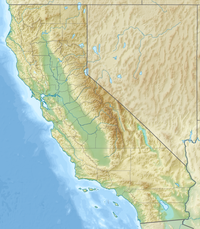Independence Peak (California)
| Independence Peak | |
|---|---|
 Northwest aspect | |
| Highest point | |
| Elevation | 11,742 ft (3,579 m) NAVD 88[1] |
| Prominence | 358 ft (109 m)[1] |
| Parent peak | University Peak[2] |
| Isolation | 1.89 mi (3.04 km)[2] |
| Listing | Sierra Peaks Section[3] |
| Coordinates | 36°45′39″N 118°19′55″W / 36.7609598°N 118.3318345°W[4] |
| Geography | |
| Country | United States |
| State | California |
| County | Inyo |
| Protected area | John Muir Wilderness |
| Parent range | Sierra Nevada |
| Topo map | USGS Kearsarge Peak |
| Geology | |
| Rock age | Cretaceous |
| Mountain type | Fault block |
| Climbing | |
| First ascent | January 17, 1926 by Norman Clyde[5] |
| Easiest route | Exposed scramble, class 3[5] |
Independence Peak is an 11,742-foot-elevation (3,579-meter) mountain summit located one mile east of the crest of the Sierra Nevada mountain range, in Inyo County of northern California.[4] It is situated immediately south of Onion Valley on the eastern boundary of John Muir Wilderness, on land managed by Inyo National Forest. It is also 8 miles (13 km) west-southwest of the community of Independence, and 1.9 miles (3.1 km) northeast of parent University Peak. Topographic relief is significant as the north aspect rises 3,600 feet (1,100 meters) above Onion Valley in one mile. Independence Peak can be climbed via the north slope from Onion Valley. The first ascent of the summit was made in 1926 by Norman Clyde, who is credited with 130 first ascents, most of which were in the Sierra Nevada.[6] He climbed this peak three times in 1926, and twice in 1927.[7] He was principal of the high school in Independence from 1924 to 1928, which provided him access to this nearest peak to his home.
Climate
[edit]According to the Köppen climate classification system, Independence Peak has an alpine climate.[8] Most weather fronts originate in the Pacific Ocean, and travel east toward the Sierra Nevada mountains. As fronts approach, they are forced upward by the peaks, causing them to drop their moisture in the form of rain or snowfall onto the range (orographic lift). Precipitation runoff from this mountain drains north into Independence Creek, thence Owens Valley.
Gallery
[edit]See also
[edit]References
[edit]- ^ a b "Independence Peak, California". Peakbagger.com. Retrieved April 25, 2021.
- ^ a b "Independence Peak CA". ListsOfJohn.com. Retrieved April 25, 2021.
- ^ "Sierra Peaks Section List" (PDF). Angeles Chapter, Sierra Club. Retrieved November 27, 2021.
- ^ a b "Independence Peak". Geographic Names Information System. United States Geological Survey, United States Department of the Interior. Retrieved April 25, 2021.
- ^ a b Secor, R.J. (1992). The High Sierra Peaks, Passes, and Trails (1st ed.). Seattle: The Mountaineers. p. 151. ISBN 978-0898863130.
- ^ "Norman Clyde - Mountaineer". OwensValleyHistory.com. Retrieved November 27, 2021.
- ^ Voge, Hervey H. (1954). A Climber's Guide to the High Sierra. Sierra Club. ISBN 978-0871560643. Retrieved November 27, 2021.
- ^ Peel, M. C.; Finlaysonv, B. L.; McMahon, T. A. (2007). "Updated world map of the Köppen−Geiger climate classification". Hydrol. Earth Syst. Sci. 11. ISSN 1027-5606.
External links
[edit]- Weather forecast: Independence Peak
- Independence Peak Rock Climbing: Mountainproject.com





